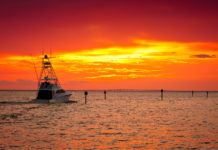Sometimes it is easy to forget that the common mockingbird and not the mosquito is Florida’s state bird, especially when more than 80 mosquito species occur throughout the state. From Spring to Fall (and year-round in some counties), mosquito control districts battle with these bloodsuckers so that outdoor activities can be nuisance-free. But Florida has been at war with mosquitoes long before the state became a top worldwide tourist destination.
In 1513 when the Spaniards came to Florida, they landed at what is known today as Ponce de Leon Inlet and promptly named it “Barro de Mosquitoes” for the torment the pests brought them. Over the years, many inlets, swamps, and lagoons would bear similar names. The land lying between the St. Johns River and the coastal lagoons north of Cape Canaveral was known as “The Mosquito Country” or “The Mosquitoes” in the 18th century, and Mosquito Country became Mosquito County in 1824. Today it is known as Orange County. When Congress was debating Florida’s statehood in 1845, the land was described as the “land of swamps, of quagmires, of frogs and alligators and mosquitoes.” Many thought the state could never be developed.
Development did come to Florida in the form of settlements mostly along the panhandle, as the peninsular portion was too swampy for habitation. Mosquitoes made settlement life difficult, however. Summers brought swarms and sicknesses that halted commerce, and disease ran rampant through people who could not afford to flee northward before the hordes of insects. Propensity for illness earned Jacksonville, St. Augustine, Tallahassee, and Pensacola the title the “malaria belt”, and yellow fever epidemics raged in 1877, 1887, and 1888, affecting thousands and prompting the creation of the State Board of Health in 1889.
The cycle of man, mosquito, and malady continued without recourse until a landmark discovery was made by Ronald Ross in 1897 that proved the role of Anopheles mosquitoes in malarial transmission, followed closely in 1901 by the discovery of yellow fever transmission via Aedes aegypti mosquitoes. Though the connection between mosquito and disease had been made, it would not be until World War I before organized control efforts were started. While there were numerous malarial control projects between then and 1941 when the Bureau of Malaria Control was created, it was the establishment of districts in 1925 dedicated to mosquito control and the subsequent digging of 1,500 miles of drainage ditches that led to a marked decrease in mosquito breeding.
The need for organized mosquito control was recognized after a dengue fever epidemic hit Miami in 1922, and the Florida Anti-Mosquito Association (now Florida Mosquito Control Association) was born to coordinate state efforts. Control endeavors shifted to local organized mosquito control through the creation of districts in 1925, beginning with Indian River Co. and followed closely by St. Lucie Co. the following year. Today, there are over 50 control districts throughout the state dedicated to protecting the public from pestiferous and disease-bearing mosquitoes.
For any questions or concerns, please contact the district at publicinformation@swcmcd.org or call (850) 267-2112.



























































